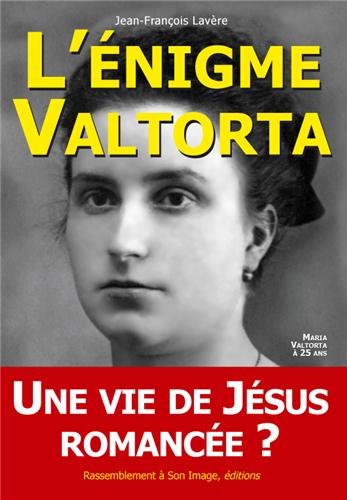
This is also available in paperback book form and in Kindle format on Amazon: The Valtorta Enigma Volume 1 on Amazon
Jean-François Lavère, a professional engineer, wrote a groundbreaking scientific study into Valtorta's primary work, entitled L´énigme Valtorta, Une Vie de Jésus Romancée? (The Valtorta Enigma, a Fictionalized Life of Jesus?). He and his publisher gave the Maria Valtorta Readers’ Group permission to provide the English translation of this work in its entirety to visitors. Download the book at the link at the top of this page.
Jean-François Lavère has been studying the works of Maria Valtorta for 25 years. Convinced that the historicity of Maria Valtorta’s work would either prove itself, or show itself to be wrong, he undertook a systematic study of thousands of details provided in her work. He has methodically identified, over the years, more than 10,000 pieces of data in her writings in fields as diverse as the arts, astronomy, flora and fauna, ethnology, geography, geology, history and geopolitical science, technology, metrology, religions, social sciences, etc., and he has shown how these details correspond to authoritative sources with remarkable accuracy. This body of evidence argues strongly in favor of the supernatural character and source of the visions described in Maria Valtorta's The Poem of the Man-God (now entitled The Gospel as Revealed to Me). Bishop Johanan-Mariam Cazenave, the Secretary of the Syrian-French Synod, wrote a preface for his book in February 2012. Below is an excerpt from his preface:
[...] This book is admirable in more than its title because, with scientific circumspection, it considers one of the great enigmas, too unknown, of our times: the case of Maria Valtorta, probably the greatest visionary in the history of Christianity! The consequences of this are considerable, because the fundamental light that Jean-François Lavère brings into this work rests on objective facts which are accessible to exact science tied to the most recent and primarily archeological discoveries. For the reader, the conclusions speak for themselves!
[...] Today, things have greatly changed. Science has progressed in an incredible way in half a century, and the computer has overturned research in all domains, unifying knowledge, classifying, coordinating analytical data. This has permitted immense progress, notably for the phenomena which concern us here: archeology and astronomy. For fifty years, let’s say from the end of the last (sic!) war, the state of Israel has encouraged excavations in all directions on most Jewish and Christian sites of its territory, precisely there where Jesus and His apostles tread two thousand years ago. A much more advanced knowledge of these sites has emerged than was available fifty years ago, giving us a multitude of places and new contexts, and details of life styles in what specialists call “Late Antiquity”.
It is precisely this which forms the power of the prodigious and patient work of Jean-François Lavère. This work in fact gives evidence of an astonishing agreement between the recent discoveries of science and the visionary descriptions of Maria Valtorta which are spread over thousands of pages: without erasures, without contradictions and in a unity of times and places as demonstrated by very rigorous research. All that, a half century ago: from the depth of her bed of suffering, without documentation and with no connection to a scientific community, this woman “sees” in real time and by a kind of shortcut: describing what some scholars would much later laboriously deduce from archeological data two thousand years old! Names of villages in Aramean, cities and monuments that disappeared and then are found again today, a knowledge of manners and customs, of scenery, attire...a whole context whereby the author of this Work amply demonstrates that this tour de force is impossible if one leaves no place for what the “seer” herself affirms: it is God who shows her, it is Jesus who dictates to her the instructions which accompany [His] illustrating the Gospels without ever betraying them: in their cultural context and often with moving poetry, consecrating the union of the True, of the Good, and of the Beautiful which rises from Christ like water from its source.
Also related to this topic, see the scientific article published in several scientific journals: Literary Fiction or Ancient Astronomical and Meteorological Observations in the Work of Maria Valtorta?
The original French version (ISBN-13: 9782364630253): L´énigme Valtorta, Une Vie de Jésus Romancée? by Jean-François Lavère at La Librairie des Éditions Catholiques.
The Italian translation (ISBN-13: 9788879871747): L’Enigma Valtorta by Jean-François Lavère at Centro Editoriale Valtortiano.
The German translation (ISBN-13: 9782880228781): Das Rätsel Valtorta: Das Leben Jesu in Romanform? by Jean-François Lavère at Parvis-Verlag.
Antonio Socci, a leading Italian journalist, TV show host, author, and public intellectual in Italy, wrote in 2012:
[…] In Maria Valtorta’s Work is found a reconstruction that is so accurate and rich in historical, geographical, and human facts about the Public Life of Jesus, that it is impossible to explain – especially if one considers that it came forth from the pen of a woman who was ignorant of these subjects and of theology, who was not familiar with the Holy Land, and who did not have any books to consult, lying sick and immobilized on a bed in Viareggio, on the Gothic Line, during the war’s most ferocious months.
There are thousands of pages, overflowing with information and with the loftiest reflections and meditations; with geographical descriptions which only today, by going onsite, would be able to be done.
There are hundreds of topographical names and details and of descriptions of places, which were unknown to almost everyone and which only the latest research and archaeological excavations have brought to light. Maria Valtorta’s Work is, in truth, inexplicable by merely human means.
The work [The Poem of the Man-God] overflows with exact data from the viewpoint of history, topography, architecture, geography, ethnology, chronology, etc. Furthermore, Maria Valtorta often provides precise details known only by some scholars, and in certain cases, she even records details totally unknown at the time she recorded them, and which archeology, history, or science have later confirmed.
The study of thousands of data, scattered as if by chance in this work, has allowed us down the years to construct an imposing documentary base. This systematic research brings to light the extraordinary precision and unsuspected level of coherence and credibility of this Life of Jesus by Maria Valtorta.
He concludes the above article:
It would certainly be possible to multiply such examples, but the "surprising" subjects in this work are still so many that we need to stop. We note only that Maria Valtorta mentions, with their names, more than 300 localities, mountains, rivers, regions, and other geographical data, and places them exactly, which is already remarkable. A complete analysis will require a voluminous work… Maria Valtorta even reached a degree of precision and exactness such as I have personally never found in the numerous authors recounting their travels in the Holy Land, and consulted by me during this study. I could furnish many examples of these.
Some critics have read the above article and thought they found several errors in some of Lavère’s claims in the above article. In Lavère’s book and even in this article, he did make some errors here and there. However, that doesn’t even come close to taking away from the immense amount of verified evidence that he amassed. Lavère analyzed about 10,000 pieces of data from Valtorta’s work, in fields as diverse as the arts, astronomy, flora and fauna, ethnology, geography, geology, history and geopolitical science, technology, metrology, religions, social sciences, etc. At present, these 10,000 pieces of data have been analyzed and compared with different sources and have shown to be extremely accurate. So what if out of the 10,000 pieces of data a small percentage turns out to be not so special or if Lavère made a few mistakes (not unlike Valtorta’s critics themselves, who have made numerous mistakes in their own articles)? That’s not really a deal-breaker nor does it take away from the mountains of evidence. It seems that critics are inclined to “throw the baby out with the bath water” just due to a few simple perceived errors (some of which oftentimes are actually based on their erroneous presumption, failure of considering plausible explanations and alternatives, and/or misreading of Valtorta’s text). As Christ said to Maria, the heaviness of humanity causes everyone to make mistakes. No research project, group, or organization is exempt.Let's just take the medical establishment for example. How many dozens and dozens of times did they make major mistakes and have to recall what they said later and revise their health theory or position? It’s been said that every decade they make major changes that depart from what they held the decade before, sometimes in opposition to what they said before. They are constantly revising what they say all of the time. There are often drug recalls, etc. You can look at almost any field of science and the greatest minds in the world make mistakes frequently, people like Thomas Edison not excluded (how many hundreds of times did his light bulb prototypes fail to work before he finally designed one that worked?). In fact, making occasional mistakes and correcting them and revising things is part of any intelligent and committed scientific method or historical, scientific, or literary endeavor. Therefore, it is completely unreasonable to reject all of Lavère’s research entirely because one discovers that a small percentage of his research findings were incorrect. If the critics of Lavère were to be that intolerant with other scholars and fields of science, then they wouldn't be able to trust or accept anything or anybody, most especially the hopelessly unscientific, illogical, and absurd fields of macroevolution (neo-Darwinism) and other “big bang” theories, which have been revised and found to be erroneous how many dozens of times in far worse ways than Lavère’s mistakes (on this topic, also see: Jesus Speaks on the Theory of Evolution to Maria Valtorta). They have to constantly revise their theories to accommodate new experimental data because they keep discovering how incorrect they are. Many scientists are too proud, close-minded, or biased to admit that there is no valid convincing scientific evidence for macroevolution but that there is a plethora of scientific evidence for Creation/Intelligent Design and even such things as a massive flood (Noah’s Flood) in past history. Some of the non-Christian critics of Lavère most probably worship this false science and don’t have problems overlooking the mistakes of the neo-Darwinists and other scientists. But they might be inclined to be intolerably unaccommodating to the small percentage of mistakes in Lavère’s research. Most of the Valtorta critics have made many mistakes themselves on many topics, and refutations of their articles demonstrate this. Hence, in the English translation of Lavère’s book, the very large number of verifiably accurate details speak for themselves and point ever more strongly to the reality that the evidence suggests and reveals that it is the most reasonable thing to conclude that what Valtorta claimed is true: she received authentic visions from a supernatural source and that she is not lying when she wrote, “I can assert that I have not had human sources to be able to know what I am writing and what, even while writing, I often do not understand.” (Maria Valtorta's Autobiography, p. 435. ISBN-13: 9788879870689)





